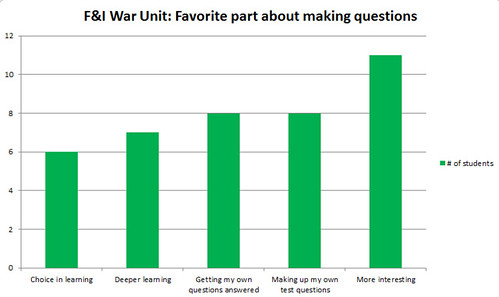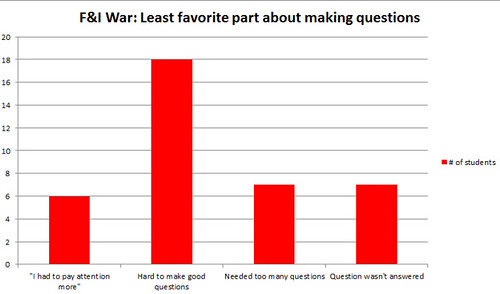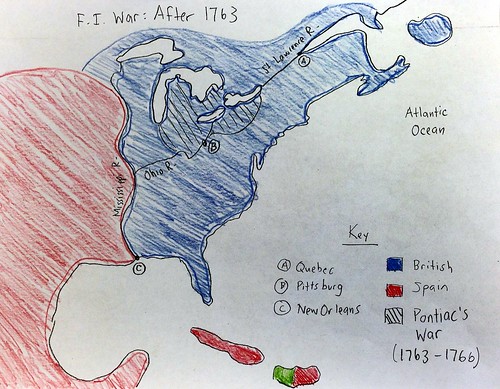Following the completion of our French and Indian War Unit, I gathered self-report data on student experiences with generating their own questions.
Due to time constraints, I only assigned the reflection to three of my five classes. A total of 65 students returned the reflection, and 50 agreed to let me use their data for this post. To facilitate analysis of the data, I transcribed all students responses to spreadsheet and coded them.
Sample student responses
Choice “We got to really learn what we wanted to.”
Deeper learning “I was able to answer my own thoughts and learn more than what basic information tells me.”
Getting my own questions answered “We got to have our own questions answered. Our curiousity still happened even when the questions did not get answered.”
Making up my own test questions “I was able to show my actual questions for the test rather than answering general questions.”
More interesting “Having my own questions made me more interested and curious about the French and Indian War.”
Sample student responses
Pay attention more “I had to do a lot more work and put in a lot more effort.”
Hard to make good questions “I didn’t like that sometimes I was unsure if my question was effective or not.”
Too many questions “It was hard to come up with a lot of good questions, because I only had a couple of ‘real’ questions.”
Questions weren’t answered “Sometimes my questions were too complicated or too confusing to find the right answer.”
Sample student responses
Causes and effects “The end of this war started a spark that became the Revolutionary War.”
George Washington “George Washington had a hard road before he became president.”
How the British won “The British were losing at first, but then they won the war.”
Individual battles “Individual battles have a large impact on the war.”
Strategies and weapons “The French learned the fighting style of the Native Americans.”
Who fought in the war “The Indians played a huge roll in the war. The Indians greatly helped the French in many battles.”
Sample student responses
Effective “I liked how he teached this unit, I feel like I really know the war and understand it.”
Videos/Visuals “Mr Walp picked a good video!”
Organization “Mr. Walp worked hard to keep everyone together with the PSSA schedule.”
Student-centered “Mr Walp built his lessons around us and what we wanted to learn.”
Variety of resources “By letting us get information from multiple resources.”
Sample student responses
Answer more questions “Mr Walp didn’t answer some of my questions.”
Give examples “He could have given us examples of questions for people who aren’t good at coming up with questions.”
More activities “Maybe use the questions for a debate?”
More lecture “Could talk more in depth about important things.”
Test too long “Very big test with lots of writing.”
Too many videos “Relied too much on videos that were confusing.”
Too much focus on making questions “Don’t make the questions such a big part next time.”
Too few videos “More videos!”
My thoughts:
General Coding data is always an interesting learning experience for me…and one with which I am never 100% fully satisfied. But I think that is just part of the process. How finely do I want to parse the data? For example, when looking at suggestions for my improvement, was it really necessary to separate “more videos” and “less videos” into different categories, especially considering there were only two respondents for “less videos”. Couldn’t I just make one code for videos? What about responses that are unclear, or don’t seem to easily fit into any of the other emergent themes? What about responses that fit more than one code theme? Dealing with these issues is part of the art and science of action research. Above all, I want to respect my students’ voices, but I cannot, and frankly should not, completely remove myself the equation. I too am part of the data.
Favorite things: In no way do I want to I want to minimize these results, but at the same time, there were no major surprises here. As I expected (hoped), student-generated questions led to a sense of empowerment, greater engagement, and a deeper understanding of the topic. I think there is clearly enough evidence to support continued use of this strategy.
Least favorite: I feel like there are two main strands in these data. One is related to student’s internal experiences with generating their own questions. For example, although many students enjoyed making their own questions, it was challenging for them to do so. The second is related to my facilitation of the strategy. I am still on my own learning curve with how best to integrate this strategy. For example, I asked students to create 10 questions from a video, but many students commented that was a particularly challenging task for them. Also, I suspected that I had not devoted enough time to answering student questions, which was confirmed by student feedback. I did try to compensate by allowing students to ask me a question on their test, but I still need to devote more time to it in class.
Most important: I was super happy to see so many students talking about causes and effects of the war, particularly the connection to the American Revolution. Not surprised that students thought George Washington was important, but it was a good reminder for me that a biographical approach can be a powerful method of engagement. I WAS completely caught off guard by how many students were confused about the difference between a battle and a war…which is actually a pretty important concept.
What I did best: I won’t lie, I always minimize good feedback about myself. I feel like, for me, that is the dark side of critical reflection. However, it was nice to read the positive comments, particularly about student-centered instruction.
How I can improve:
If I am going to have students make their own questions, I have to invest more time to make sure I answer as many as possible. I won’t commit to answering them all though. There’s not enough time to do so, AND I think it is also important for students to realize that we don’t always have all the answers. History is not fully known and understood even by experts.
The test was too long, I’m going to pay for it with amount of time it will take to grade them all. Another trend of mine…my third quarter tests are always the most ambitious, and then I ease up a bit going into the fourth quarter. I don’t think I need to change that, but it’s probably important for me to be aware of it.
More videos. Less videos. The debate rages on… The main problem is that the video was hard to follow at times because it bounced back and forth between different theaters of the war. Next time I’ll need to use more editorial license to make it more easily digestible.
It’s weird…I am always so focused on writing process, and students discovering their own information, that I almost have an aversion to simply lecturing once in awhile. But everything has its place, and sometimes direct instruction is the best, and most appropriate, way to tie everything together and provide context. Of course I am on my third curriculum in three years, so I am also dealing with my own learning curve in the content and pacing.
Comments and feedback welcome!







